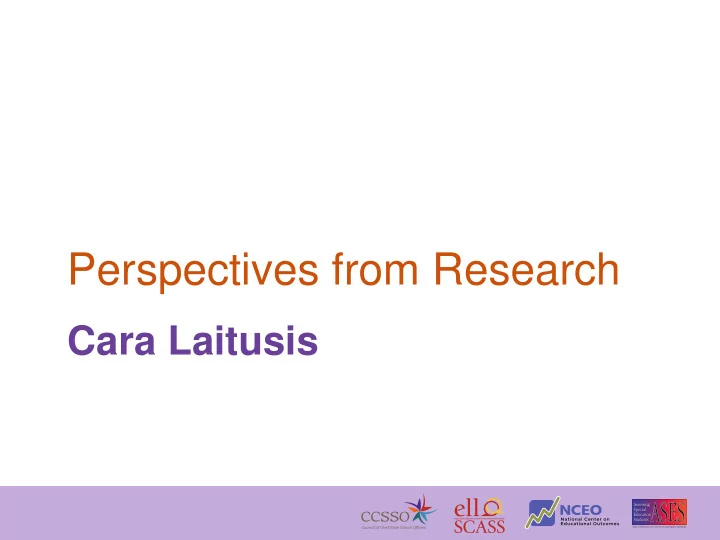

Perspectives from Research Cara Laitusis
Overview ▪ What do we know? – Overview of recent meta-analyses – Summary of findings ▪ What are the challenges of conducting research? ▪ Future research studies ▪ What would you do?
What do we know? Numerous studies examining “read aloud” ▪ 3 meta- analysis of “differential boost” in last 3 years – Buzick, H. M., & Stone, E. A. (2014). A meta-analysis of research on the read aloud accommodation. Educational Measurement: Issues and Practice, 33(3), 17 – 30. – Li, H. (2014). The effects of read-aloud accommodations for students with and without disabilities: A meta-analysis. Educational Measurement: Issues and Practice, 33, 3 – 16. – Wood, S.G., Moxley, J.H., Tighe, E.L., & Wagner, R.K. (2017). Does Use of Text- to-Speech and Related Read-Aloud Tools Improve Reading Comprehension for Students With Reading Disabilities? A Meta-Analysis. Journal of Learning Disabilities, 1-12. ▪ Numerous studies comparing psychometric comparability ▪ Few studies examining predictive validity
Summary of Buzick & Stone Meta-Analysis (2014) ▪ 22 studies on reading ▪ 26 studies on mathematics ▪ Among the studies that were suitable to include in the meta-analysis: – 9 comparisons in reading – 20 comparisons in math
Variety of Audio Presentation ▪ Delivery options – Text to speech – Prerecorded text to speech – Prerecorded human audio – Human proctor (scripted or on the fly) – Individual vs. group administration – Student-paced vs. computer/proctor-paced – Ability to reread (i.e., words, phrases, sentences)
Variety of Audio Presentation ▪ Amount of text read aloud – Passages – Parts of passages/questions • proper nouns on ELA test • no numerals or symbols on math test – Questions and answer options – Directions
Reading Summary of comparisons Grade Elementary school (4) Middle school (4) Middle & High (1) Type of audio Human reader (4) presentation Audio CD (2) Text-to-speech (2) Video (1) Extra time Accommodated only (3) Standard and accommodated (3) None/unknown (3) Item types Similar to state assessment (5) Other (4) 8 of 22 studies included in Smarter Balanced Literature Review
Math Summary of comparisons Grade Elementary school (10) Middle school (8) High school (2) Type of audio Human reader (8) presentation Video (10) Text-to-speech (2) Extra time Accommodated only (2) Standard and accommodated (13) None/unknown (5) Item types Similar to state assessment (17) CBM or performance assessment (3) 14 of 35 studies included in Smarter Balanced Literature Review
9
10
TTS Meta-analysis (2017)
Taken together, this more studies are needed to further suggests that text to- explore the moderating variables of speech technologies may text-to-speech and read- aloud tools’ assist students with effectiveness for improving reading Comprehension (Wood et al., 2017) reading comprehension. (Wood, et al. 2017) but there is a substantial We conclude that we can expect amount of variation in effect larger score gains on average from sizes that is due to factors the read aloud accommodation on beyond measurement error reading assessments than on math (Buzick & Stone, 2014) assessments (Buzick & Stone, 2014)
What do we know? ▪ Read aloud improves scores, but effect sizes are larger for reading than for math for both student groups – Human reader had larger effect size (Li, 2014) – Early grades had larger effect size (Buzick & Stone, 2014) ▪ Differential performance gains are found on reading tests, but no/minimal differential performance gains are found in mathematics
What do we know? ▪ Scores with and without read aloud are psychometrically comparable* (i.e., Reliability, Factor Structure, and Differential Item Functioning) – *Nearly all of these studies were done with human readers or prerecorded audio (see Laitusis & Cook, 2008 for summary) – Studies should be replicated for CBT and TTS and can be done with operational test data ▪ Limited research on predictive validity but research on teachers ratings and college readiness is conflicting – Lessons learned from PARCC TTS Predictive Validity Study
Challenges ▪ Defining the construct – Does reading include decoding of print by touch or sight? If so, • How long do you have to decode? • Can a reading fluency test supplement comprehension tests? – What are we predicting? • Independent comprehension of text? • College grades? • Teachers ratings?
Challenges ▪ What grade level does comprehension over take decoding ▪ Item level accommodation use does not fit old paradigm of “differential boost” or “interaction hypothesis” ▪ Few studies on predictive validity
Future Research Studies ▪ For the most part…. forget about differential boost for isolated accommodations/tools ▪ Focus on predictive validity of total score – Tracking students to college/career • Employment/High School Graduation/College Graduation rates • Grades in entry level courses – Predicting other variables • Future test scores • High School grades • Teacher Ratings
Future Research Studies ▪ Descriptive analysis of operational test data and surveys – Longitudinal accommodation use – Click stream data by item • Was assigned tool/feature used? • What other tools and features were used with TTS? • Do students who use AIM also use TTS tool? • Are there performance differences for students who use different TTS as an instructional accommodation?
What would you do? ▪ Change policy to only allow independent forms of read aloud on reading test after grade 6 – Text to Speech or Screen Reader ▪ Include supplemental measure of oral reading fluency – when read aloud is provided on reading tests in grades 3-5 ▪ Capture data on – Longitudinal accommodation use (for predictive validity studies) – Specific accommodation use by item and item elements (passage, stem, options) and make it available to researchers – Student survey on instructional accommodations
Questions/Comments: Cara Laitusis claitusis@ETS.org @CaraLaitusis www.linkedin.com/in/Cara-Laitusis
Recommend
More recommend